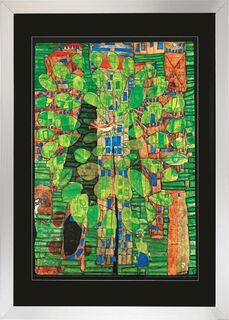Picture "Singing Bird on a Tree in the City", framed


Picture "Singing Bird on a Tree in the City", framed
Quick info
limited, 2,000 copies | reproduction on handmade paper | framed | size 63 x 86 cm (w/h)
Detailed description
Picture "Singing Bird on a Tree in the City", framed
Gridless granolitho in 10 colours on 270g Rives handmade paper at Lichtdruck AG, Zurich, Switzerland. Mirrored reproduction of the original, limited edition of 2,000 copies. Published by the Museumsbetriebsgesellschaft Wien. Size 56 x 77 cm (w/h). Framed in a silver solid wood frame. Size 63 x 86 cm (w/h).
The displayed works of art are protected by copyright. In particular, it is not permitted to copy, edit, print or publish these illustrations. Violations will be prosecuted according to civil and criminal law.
Customer reviews
Qualitativ sehr gute Reproduktion des Bildes. Schnelle Lieferung und sehr sorgfältige Verpackung.

About Friedensreich Hundertwasser
1928-2000
Hundertwasser is one of the most internationally renowned artists of our time. His worldwide reputation was already established in the 1960s. Followed by an eventful and evocative career. His aura and power emerged from his painting and multifaceted work.
Organizing demonstrations, speeches, happenings and campaigns, addressing ecological issues, advocating a life in harmony with nature, manifestos for nature, standing up for a more humane architecture and the improvement of people's lives.
Hundertwasser originated projects such as the tree tenants, the roof afforestation, the regreening of cities, the humus toilet, the restoration of social values and the natural cycles. He was an admonisher against environmental pollution, against the dangers of nuclear energy, against natural degradation and the destruction of natural heritage, and in favour of a waste-free society.
Hundertwasser has been engaged with architecture since the 1950s. On the occasion of the inauguration of the Hundertwasser House of the City of Vienna (1986), he said: "We are again experiencing a turning point where old and rigid values in architecture and urban developement are increasingly being questioned. The straightness and uniformity of Bauhaus architecture is coming to an end because it is callous, sterile, cold, heartless, aggressive and emotionless. The era of absolute rationalism is coming to an end. The new values are enhanced quality of life, not standard of living. Longing for romance, individuality, creativity, especially creativity and living in harmony with nature."
With Friedensreich Hundertwasser, our epoch has found the most imposing challenger of totalitarian thinking, whether it concerns nuclear energy, genetic manipulation, environmental protection or the design of our living space. Hundertwasser lived completely in harmony with his view of things and opposing the contradictions of post-industrial society. Hundertwasser's significance is his art that produces beauty: a message of natural harmony, peace and joy.


